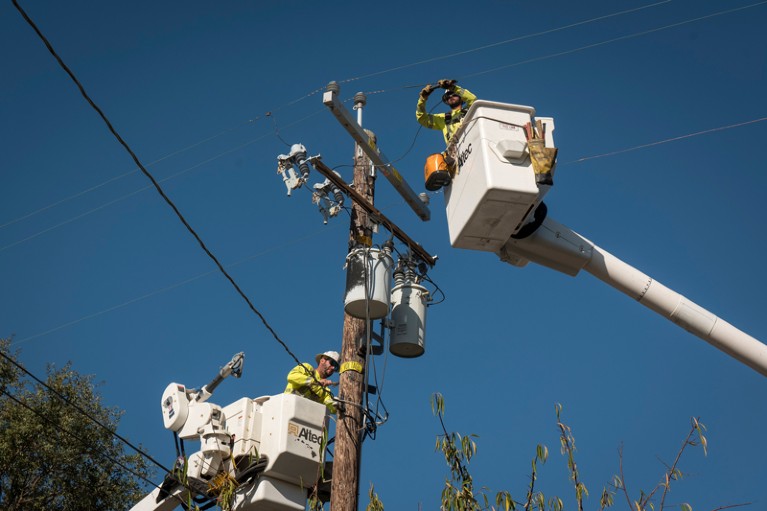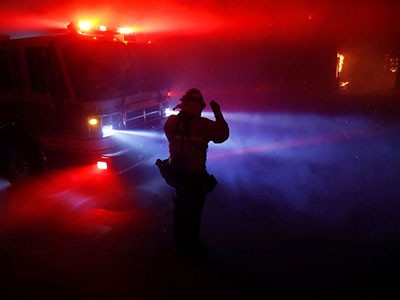
California’s electricity distribution grid badly needs an upgrade.Credit: David Paul Morris/Bloomberg/Getty
Confusion reigned the first time that the University of California, Berkeley, lost its connection to the city’s electricity grid, on 9 and 10 October. Campus officials were unable to say how long the university’s power plant could provide emergency electricity for crucial facilities — such as freezers containing valuable research specimens. Some scientists didn’t even know which electric plugs to use to access back-up power. As a precaution, researchers packed freezers with dry ice, and some sent their most important samples to other institutions.
This chain of events can be traced back to last November, when a faulty transmission line sparked the deadliest wildfire in California’s history. The Camp Fire tore through the town of Paradise, killed 86 people and levelled thousands of homes and businesses.
Faced with an estimated US$30 billion in insurance claims from that fire and others in 2017, the state’s largest utility provider, San Francisco-based Pacific Gas and Electric Company (PG&E), filed for bankruptcy in January. Then, when hot, dry winds raised the fire danger in early October, the company cited legitimate liability concerns and shut down major sections of the electricity grid to prevent more blazes from breaking out.
Evidence that global warming is promoting more frequent and severe wildfires has been mounting for decades, and the fact that electrical equipment can start fires, and contribute to their spread, is hardly news. But few could have predicted that vast stretches of California — the world’s fifth-largest economy and a global hub for research and innovation — would be paralysed by a combination of wildfire and electricity blackouts.
California wildfires and power outages cause disruptions for scientists
Safeguarding lives and habitats from these catastrophes has to be the top priority for the state’s decision makers. Solutions for upgrading the grid range from the obvious to the technological. Electrical equipment should be kept clear of vegetation, with power lines buried underground, where feasible. Cameras, sensors and other systems could allow grid operators to detect and isolate problems with speed and precision. There are also measures that Berkeley and other institutions can take, such as reducing their energy demands and allocating limited emergency power to only the most urgent needs.
At the same time, California’s research and technology institutions, and its decision makers, could harness more of the state’s considerable research muscle in energy and energy policy to address the bigger picture: creating a more resilient, cleaner grid for the whole state.
Researchers at Berkeley and elsewhere have spent years developing smart-grid technologies that allow more control of where electricity goes and when. Economists are calculating the costs and benefits of different kinds of energy infrastructure, such as installing solar panels, or using fuel cells powered by renewably produced hydrogen.
More of this pioneering work should be deployed to solve problems in the institutions’ home state. Like the back-up power system that Berkeley used when the grid failed, a wider network of increasingly smaller grids that can be isolated or boosted as needed might be the future.
California’s fires are now a chronic problem. A safe, clean, efficient and resilient grid has to be a shared responsibility, and not something for politicians alone to fix. The state’s dynamic research, technology and innovation communities must step up to solve the problems in their individual organizations and at the same time craft wider solutions that help California — along with regions worldwide — adapt to our thirst for more energy in an increasingly warmer world.

 California biologists are using wildfires to assess health risks of smoke
California biologists are using wildfires to assess health risks of smoke
 California wildfires and power outages cause disruptions for scientists
California wildfires and power outages cause disruptions for scientists
 Massive California power outage triggers chaos in science labs
Massive California power outage triggers chaos in science labs







